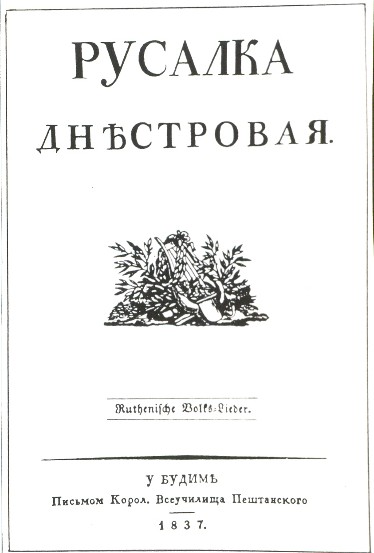Rusalka Dnistrovaia
Rusalka Dnistrovaia (The Dnister Nymph), subtitled Ruthenische Volks-Lieder. The first Ukrainian literary and folkloric almanac published in Galicia. It was compiled by the Ruthenian Triad (Markiian Shashkevych, Yakiv Holovatsky, and Ivan Vahylevych) and printed through their efforts in the hrazhdanka script in Buda, Hungary, in December 1836. The almanac consisted of folk songs recorded in various places in Galicia, with an introduction by Vahylevych; poetry and prose by the Triad's members and their translations of Serbian folk poetry and excerpts from V. Hanka's ‘Králové Dvůr Manuscript’; texts of lyrical and heroic poetry from a 15th-century manuscript, with an introduction by Shashkevych; Holovatsky's note on Slavonic manuscripts in the library of Saint Basil's Monastery in Lviv; and Shashkevych's review of Yosyp Lozynsky's 1835 book of Ukrainian wedding rituals. In the manifesto-like preface Shashkevych stressed the beauty of the Ukrainian vernacular and folk oral literature and provided a list of the most important contemporary publications of literature and folklore in Russian-ruled Ukraine. Of the original 1,000 copies 800 were confiscated in Lviv by the police after its sale, and distribution in Galicia was banned by Venedykt Levytsky, the provincial censor, who did not approve of the language and orthography or of some of the contents. (The ban, which was not in effect in other provinces in the Austrian Empire, was rescinded in 1848.) Nonetheless, because of the compilers' radical Romantic orientation toward a pan-Ukrainian folk culture, literature, and history, their promotion of the vernacular as the literary Ukrainian language, and their pioneering use of a phonetic orthography based on the vernacular, Rusalka Dnistrovaia had a seminal impact on national consciousness and literature in Western Ukraine. It was republished in Ternopil in 1910, and facsimile editions of the original appeared in Kyiv in 1950 and 1972 and in Philadelphia in 1961.
Roman Senkus
[This article originally appeared in the Encyclopedia of Ukraine, vol. 4 (1993).]
